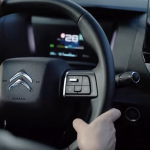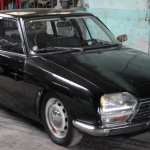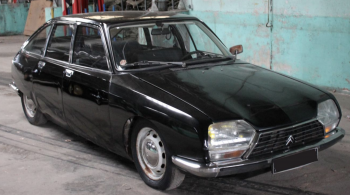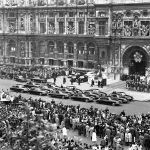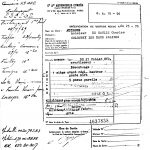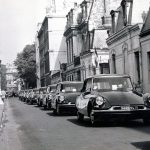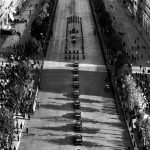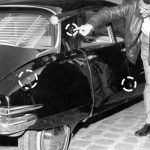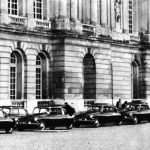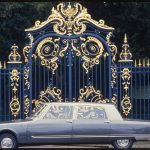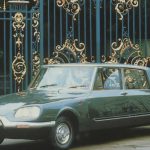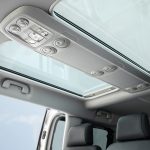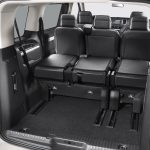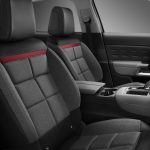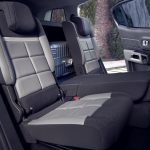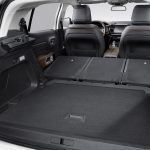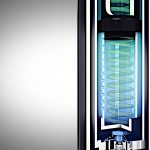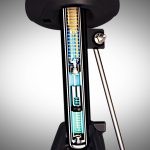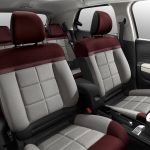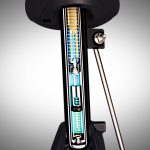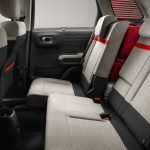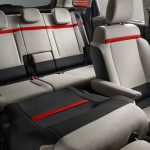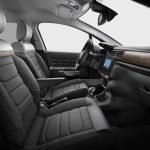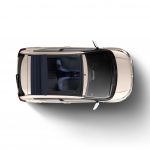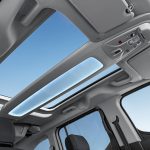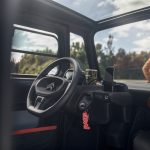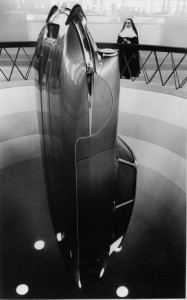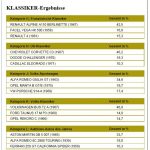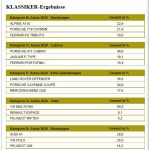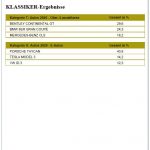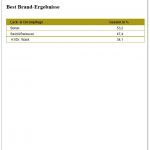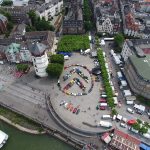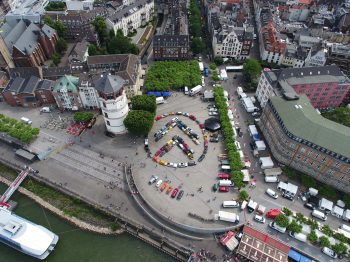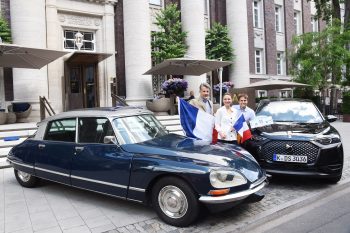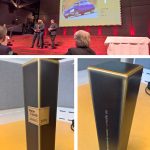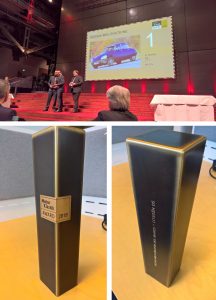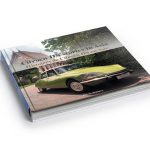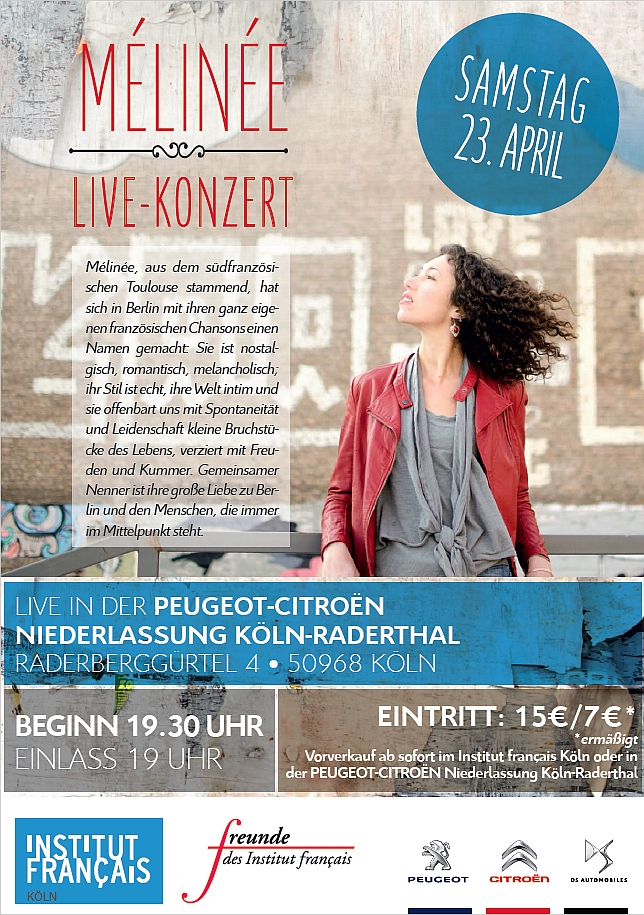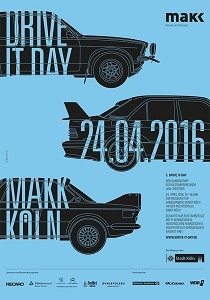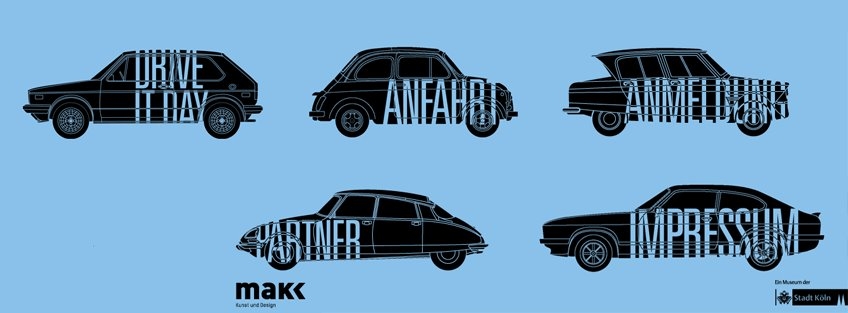(english below, en francais au-dessous)
Die Pressemitteilung von DS Automobiles:
* Oktober 1955: Weltpremiere der DS 19 auf dem Pariser Automobilsalon
* Geschichtsstunde zum Jubiläum: Staatspräsident Charles de Gaulle im Portrait
* Lebenslange Liebe: Charles de Gaulle und seine besondere Beziehung zur DS
Vor genau 65 Jahren wurde die DS 19 auf dem Pariser Automobilsalon erstmals der Öffentlichkeit präsentiert und schrieb von Beginn an automobile Geschichte. Anlässlich dieses Jubiläums taucht DS Automobiles in ein wichtiges Stück DS-Geschichte ein und gibt Einblicke in die besondere Beziehung des französischen Staatsoberhaupts Charles de Gaulle zu seinen DS Fahrzeugen. Als Widerstandskämpfer und Präsident prägte de Gaulle nicht nur ganz Frankreich, sondern auch die Geschichte der DS. Seine Liebe zur avantgardistischen Ikone, das Überleben eines Terrorangriffs dank seiner DS und die gepanzerten Staats-DS sind Teil dieser speziellen Verbindung.
Nachdem General de Gaulle Frankreichs Widerstand gegen die Besatzer im Zweiten Weltkrieg angeführt und mit einem Appell an seine Landsleute große Bekanntheit erreicht hatte, wurde er 1959 zum Präsidenten der Republik gewählt. Seine Regierungszeit dauerte bis 1969 an – ein Jahrzehnt, das das Land und die Franzosen selbst maßgeblich prägte. Der Gaullismus, der die auf ihn zurückgehende politische Ideologie beschreibt, beeinflusst bis heute die französische Politik.
Neben den politischen Veränderungen, die seine Amtszeit mit sich brachte, setzte sich de Gaulle nach seiner Ernennung zum französischen Präsidenten auch für die Erneuerung des Élysée-Fuhrparks ein. Bereits vier Jahre zuvor – im Jahr 1955 – war die neue und avantgardistische DS 19 auf dem Pariser Automobilsalon der Öffentlichkeit präsentiert worden. Mit ihrer Eleganz und technologischen Raffinesse verkörperte sie perfekt das Ideal Frankreichs und stand damit sinnbildlich für dessen „Größe“. Damit begeisterte die DS 19 nicht nur das Publikum auf dem Pariser Automobilsalon, sondern imponierte auch de Gaulle persönlich.
Jeder Auftritt des Präsidenten, jede Parade, jeder öffentliche Termin von Ministern, Abgeordneten sowie Bürgermeistern wurde fortan von einer Vielzahl auffälliger, tiefschwarzer DS begleitet, die schnell zum Symbol der Staatspräsenz wurden. De Gaulle nutzte zur Beschaffung aller Fahrzeuge stets den engen Kontakt zu seinem Händler des Vertrauens. Entgegen aller Erwartungen entschied sich de Gaulle nicht für die DS Prestige, ein Modell bei dem zwischen Rücksitzen und Fahrer eine Trennung bestand, sondern für die normale Limousine. Da er seinen Chauffeur als Freund und Vertrauten betrachtete, akzeptierte er keine „Mauer“ zwischen beiden – so konnte sich de Gaulle insbesondere auch auf längeren Fahrten bequem mit seinem Chauffeur unterhalten.
Im August 1962 kam es zum Attentat von Petit Clamart. De Gaulle war aus den Sommerferien zu einem dringenden Ministerrat nach Paris zurückgekehrt. Ein Flugzeug brachte ihn zum Militärflughafen von Villacoublay und von dort fuhr er mit seiner DS 19 weiter nach Paris. Sowohl auf dem Hin- als auch auf dem Rückweg wurde er von Polizisten auf Motorrädern begleitet. Auf dem Rückweg passierte es dann: Während der Fahrt nach Villacoublay eröffnete eine Gruppe Terroristen das Feuer auf die DS des Generals. Zwei Reifen – einer vorne, der andere hinten – wurden getroffen und zerstört. Trotzdem gelang es dem Fahrer noch zu beschleunigen und die Angreifer abzuhängen. Der Konvoi überstand den Angriff ohne Verletzte.
Dieser Zwischenfall machte die einzigartigen Fahreigenschaften der DS 19 über Nacht weltbekannt und stellte den General gleichermaßen vor ein großes Problem: De Gaulle wollte nichts davon wissen, zukünftig ein gepanzertes Fahrzeug zu nutzen. Er liebte den Kontakt zu Menschen, benutzte selten Flugzeuge und Hubschrauber und zog seine DS stets vor. Trotz seiner anfänglichen Bedenken und nachdem es weitere Hinweise auf mögliche Terroranschläge gab, stimmte de Gaulle schließlich zu, ein spezielles gepanzertes Fahrzeug anzuschaffen – vorausgesetzt natürlich, es wäre eine DS.
Umgehend wurde ein Team um den jungen Robert Opron, einen Schüler von Flaminio Bertoni, mit der Umsetzung des Projektes beauftragt. Der Bau wurde dem Karosseriehersteller Chapron aus Levallois anvertraut, der bereits einige Jahre eng mit Citroën bei der Herstellung von Cabriolets auf DS Basis zusammenarbeitete. Die Entwurfsphase begann 1964, jedoch verzögerten der Tod von Flaminio Bertoni und die bevorstehende Einführung einer neuen Version der DS 19 – leistungsstärker und robuster – die Fertigstellung bis in die zweite Jahreshälfte 1965. Die neue DS 21 war besser geeignet, gleichzeitig das Gewicht der imposanten Panzerung und die Karosserie zu tragen.
Der General und seine Frau wurden persönlich nach Levallois eingeladen, um die hölzerne „Maquette“ (das Modell) des neuen Autos zu begutachten. Das Design der neuen Staats-DS soll de Gaulle zunächst mit heftigem Kopfschütteln quittiert haben. Besonders die innere Panzerwand der „Présidentielle” missfiel ihm: Sie trennte ihn vom Fahrer, war mehrere Zentimeter dick, unbeweglich und nicht absenkbar. Es dauerte einige Zeit, den hochrangigen Gast zu beruhigen. Erst nachdem er die Sitze des Modells ausprobiert hatte, heiterte sich seine Stimmung auf. Er stand auf, verabschiedete sich von den Entwicklern und ließ sie noch vor seinem Rückweg in den Élysée-Palast wissen: Sie dürften weitermachen!
Die Mechanik der DS Présidentielle wurde aus der herkömmlichen DS 21 übernommen. Darüber hinaus waren einige Extras hinzugefügt worden, die es dem „1-PR-75“ (gesetzlich zugewiesenes Kennzeichen) ermöglichten, auch stundenlang mit sehr niedriger Geschwindigkeit zu fahren (unverzichtbar bei Paraden), ohne dass die interne Klimaanlage ausfiel oder der Motor überhitzte. Im Inneren gab es allen erdenklichen Luxus, sogar einen „Briefkasten“, mithilfe dessen Nachrichten zwischen den Rücksitzen und dem Feldassistenten des Generals ausgetauscht werden konnten, der neben dem Fahrer saß. Die Staats-DS wurde 1968 ausgeliefert. Der General benutzte sie bei offiziellen Anlässen jedoch nur dreimal, da er zu diesem Zeitpunkt seine neue DS 21 Pallas bevorzugte, die er wie immer von seinem befreundeten Händler gekauft hatte.
Nachdem Charles de Gaulle das Referendum über die Verfassungsreform verloren hatte, trat er 1969 zurück und überließ die Führung des Landes Georges Pompidou. Der neue Präsident sollte das gepanzerte Staatsgefährt häufiger einsetzen – allerdings hatte sich in der Zwischenzeit die Mode so geändert, dass das Design der „1-PR-75“ endgültig überholt war. So kamen die klassischen DS Limousinen wieder in Mode: Ihnen konnten weder Zeit noch Mode etwas anhaben, da sie sich durch einen zeitlosen Stil auszeichnen. Bei offiziellen Anlässen wurden sie häufig von zwei viertürigen SM Cabriolets flankiert, die noch heute Teil des Élysée-Fuhrparks sind.
Kontakt
DS Automobiles
Leiterin Presse und Öffentlichkeitsarbeit
Dorothea Knell
Telefon: +49 170 9174 426
E-Mail: dorothea.knell@dsautomobiles.com
—–
The press release of “DS Automobiles” in Germany, best-effort translation by Amicale:
* October 1955: World premiere of the DS 19 at the Paris Motor Show
* History lesson on the anniversary: Portrait of President Charles de Gaulle
* Lifelong love: Charles de Gaulle and his special relationship with DS
Exactly 65 years ago, the DS 19 was presented to the public for the first time at the Paris Motor Show and wrote automotive history right from the beginning. On the occasion of this anniversary, DS Automobiles delves into an important piece of DS history and provides insights into the special relationship between the French head of state Charles de Gaulle and his DS vehicles. As a resistance fighter and president, de Gaulle not only shaped the whole of France, but also the history of DS. His love for the avant-garde icon, the survival of a terrorist attack thanks to his DS and the armored governmental DS are part of this special relationship.
After General de Gaulle had led France’s resistance against the occupying forces in World War II and achieved great notoriety with an appeal to his compatriots, he was elected President of the Republic in 1959. His term of office lasted until 1969 – a decade that had a major impact on the country and the French people themselves. Gaullism, which describes the political ideology that goes back to him, still influences French politics today.
In addition to the political changes brought about by his term of office, de Gaulle also worked to renew the Élysée vehicle fleet after his appointment as French president. Four years earlier – in 1955 – the new and avant-garde DS 19 had already been presented to the public at the Paris Motor Show. With its elegance and technological sophistication, it perfectly embodied the ideal of France and was thus symbolic of its “greatness”. Thus the DS 19 not only thrilled the audience at the Paris Motor Show, but also impressed de Gaulle personally.
From then on, every appearance by the President, every parade, every public appointment of ministers, members of parliament and mayors was accompanied by a multitude of eye-catching, jet-black DS, which quickly became a symbol of the state presence. De Gaulle always used the close contact to his trusted dealer to procure all vehicles. Contrary to all expectations, de Gaulle did not opt for the DS Prestige, a model in which there was a separation between the rear seats and the driver, but for the normal sedan. Since he regarded his chauffeur as a friend and confidant, he did not accept a “wall” between the two – so de Gaulle was able to talk comfortably to his chauffeur, especially on longer journeys.
In August 1962, the attack at Petit Clamart happened. De Gaulle had returned to Paris from the summer vacations for an urgent Council of Ministers meeting. A plane took him to the military airport of Villacoublay and from there he continued his journey to Paris with his DS 19. Both on the outward and return journey he was accompanied by policemen on motorcycles. On the way back, it happened: while driving to Villacoublay, a group of terrorists opened fire on the general’s DS. Two tires – one in the front, the other in the back – were hit and destroyed. Nevertheless, the driver still managed to accelerate and outrun the attackers. The convoy survived the attack without injuries.
This incident made the unique driving characteristics of the DS 19 world-famous overnight and presented the General with an equally big problem: De Gaulle did not want to know about using an armored vehicle in the future. He loved contact with people, rarely used airplanes and helicopters and always preferred his DS. Despite his initial reservations and after further indications of possible terrorist attacks, de Gaulle finally agreed to purchase a special armored vehicle – provided, of course, that it was a DS.
A team led by the young Robert Opron, a student of Flaminio Bertoni, was immediately assigned to implement the project. The construction was entrusted to the body manufacturer Chapron from Levallois, who had already worked closely with Citroën for several years on the production of convertibles based on DS. The design phase began in 1964, but the death of Flaminio Bertoni and the imminent introduction of a new version of the DS 19 – more powerful and more robust – delayed completion until the second half of 1965. The new DS 21 was better able to carry the weight of the imposing armour and the bodywork at the same time.
The General and his wife were personally invited to Levallois to inspect the wooden “maquette” (the model) of the new car. De Gaulle is said to have initially commented the design of the new state DS by shaking his head violently. He particularly disliked the inner armour wall of the “Présidentielle”: it separated him from the driver, was several centimeters thick, immovable and could not be lowered. It took some time to calm down the high-ranking guest. Only after he had tried out the seats of the model did his mood brighten. He got up, said goodbye to the developers and let them know before he went back to the Élysée Palace: You may continue!
The mechanics of the DS Présidentielle were taken from the conventional DS 21. In addition, some extras had been added that allowed the “1-PR-75” (legally assigned license plate) to run at very low speed for hours (indispensable for parades) without the internal air conditioning failing or the engine overheating. Inside, there was every luxury imaginable, even a “mailbox” that allowed messages to be exchanged between the rear seats and the general’s field assistant, who sat next to the driver. The governmental DS was delivered in 1968. However, the General only used it three times on official occasions, as he preferred his new DS 21 Pallas at that time, which he had bought as usual from his friendly dealer.
After Charles de Gaulle lost the referendum on constitutional reform, he resigned in 1969 and left the leadership of the country to Georges Pompidou. The new president was supposed to use the armored state vehicle more often – but in the meantime fashion had changed so much that the design of the “1-PR-75” was finally outdated. So the classic DS sedans came back into fashion: Neither time nor fashion could harm them, as they are characterized by a timeless style. On official occasions they were often flanked by two four-door SM convertibles, which are still part of the Élysée fleet today.
Press Contact Germany:
DS Automobiles
Head of External Communications
Dorothea Knell
Telefon: +49 170 9174 426
E-Mail: dorothea.knell@dsautomobiles.com
—–
Notre traduction en francais, d’un lancement de presse de “DS Automobiles” en R.F.A.:
* Octobre 1955 : Première mondiale de la DS 19 au Salon de l’automobile de Paris
* Leçon d’histoire sur l’anniversaire : Portrait du président Charles de Gaulle
* Amour de toujours : Charles de Gaulle et sa relation particulière avec DS
Il y a exactement 65 ans, la DS 19 était présentée au public pour la première fois au Salon de l’automobile de Paris et a écrit l’histoire de l’automobile dès le début. À l’occasion de cet anniversaire, DS Automobiles se penche sur un épisode important de l’histoire de la DS et donne un aperçu de la relation particulière qu’entretenait le chef de l’État français Charles de Gaulle avec ses véhicules DS. En tant que résistant et président, de Gaulle a non seulement marqué la France entière, mais aussi l’histoire de DS. Son amour pour l’icône de l’avant-garde, la survie d’un attentat terroriste grâce à sa DS et la DS de l’État blindée font partie de cette relation particulière.
Après que le général de Gaulle ait mené la résistance de la France contre l’occupant pendant la Seconde Guerre mondiale et ait acquis une grande notoriété en faisant appel à ses compatriotes, il est élu président de la République en 1959. Son mandat a duré jusqu’en 1969 – une décennie qui a eu un impact majeur sur le pays et les Français eux-mêmes. Le gaullisme, qui décrit l’idéologie politique qui remonte à lui, influence encore aujourd’hui la politique française.
Outre les changements politiques apportés par son mandat, M. de Gaulle a également travaillé au renouvellement de la flotte de l’Élysée après sa nomination à la présidence de la France. Quatre ans plus tôt – en 1955 – la nouvelle et avant-gardiste DS 19 avait déjà été présentée au public au Salon de l’automobile de Paris. Par son élégance et sa sophistication technologique, il incarnait parfaitement l’idéal de la France et symbolisait ainsi sa “grandeur”. La DS 19 a donc non seulement enthousiasmé le public du Mondial de l’Automobile de Paris, mais a également impressionné de Gaulle personnellement.
Chaque apparition du président, chaque défilé, chaque nomination publique de ministres, de députés ainsi que de maires est désormais accompagnée d’une multitude de DS d’un noir profond et accrocheur, qui devient rapidement un symbole de la présence de l’État. De Gaulle a toujours utilisé le contact étroit avec son concessionnaire de confiance pour se procurer tous les véhicules. Contrairement à toute attente, de Gaulle n’a pas opté pour la DS Prestige, un modèle dans lequel il y avait une séparation entre les sièges arrière et le conducteur, mais pour la berline normale. Comme il considérait son chauffeur comme un ami et un confident, il n’acceptait pas qu’il y ait un “mur” entre les deux – cela signifiait que de Gaulle pouvait parler confortablement à son chauffeur, surtout lors de longs trajets.
En août 1962, Petit Clamart est assassiné. De Gaulle était rentré à Paris après les vacances d’été pour une réunion urgente du Conseil des ministres. Un avion l’amène à l’aéroport militaire de Villacoublay et de là, il se rend à Paris avec sa DS 19. À l’aller comme au retour, il était accompagné de policiers à moto. Sur le chemin du retour, cela s’est produit : pendant la route vers Villacoublay, un groupe de terroristes a ouvert le feu sur la DS du général. Deux pneus – l’un à l’avant, l’autre à l’arrière – ont été touchés et détruits. Néanmoins, le conducteur a quand même réussi à accélérer et à perdre les attaquants. Le convoi a survécu à l’attaque sans blessures.
Cet incident a rendu les caractéristiques de conduite uniques de la DS 19 mondialement célèbres du jour au lendemain et a posé un problème tout aussi important au général : De Gaulle ne voulait rien savoir de l’utilisation d’un véhicule blindé à l’avenir. Il aimait le contact avec les gens, utilisait rarement des avions et des hélicoptères et préférait toujours sa DS. En dépit de ses réserves initiales et après que de nouvelles indications sur d’éventuelles attaques terroristes aient été fournies, de Gaulle a finalement accepté d’acheter un véhicule blindé spécial – à condition, bien sûr, qu’il s’agisse d’une DS.
Une équipe dirigée par le jeune Robert Opron, un élève de Flaminio Bertoni, a été immédiatement affectée à la mise en œuvre du projet. La construction a été confiée au carrossier Chapron de Levallois, qui avait déjà travaillé en étroite collaboration avec Citroën pendant plusieurs années sur la production de cabriolets basés sur DS. La phase de conception commence en 1964, mais la mort de Flaminio Bertoni et l’introduction imminente d’une nouvelle version de la DS 19 – plus puissante et plus robuste – retardent l’achèvement des travaux jusqu’au second semestre 1965. La nouvelle DS 21 est mieux adaptée pour supporter le poids de l’imposante armure et de la carrosserie en même temps.
Le général et son épouse ont été personnellement invités à Levallois pour inspecter la “maquette” en bois de la nouvelle voiture. De Gaulle aurait d’abord reconnu la conception du nouvel État DS en secouant violemment la tête. Il déteste particulièrement le mur de protection intérieur de la “Présidentielle” : il le sépare du chauffeur, il est épais de plusieurs centimètres, inamovible et ne peut être abaissé. Il a fallu un certain temps pour calmer l’invité de haut rang. Ce n’est qu’après avoir essayé les sièges de la maquette que son humeur s’est éclaircie. Il se lève, dit au revoir aux promoteurs et leur fait savoir avant de retourner au Palais de l’Élysée : Vous pouvez continuer !
La mécanique de la DS Présidentielle a été reprise de la DS 21 classique. En outre, quelques extras avaient été ajoutés, qui permettaient au “1-PR-75” (plaque d’immatriculation légalement attribuée) de rouler pendant des heures à très basse vitesse (indispensable pour les défilés) sans que le système de climatisation interne ne tombe en panne ou que le moteur ne surchauffe. À l’intérieur, il y avait tout le luxe imaginable, même une “boîte aux lettres” qui permettait d’échanger des messages entre les sièges arrière et l’assistant de terrain du général, qui était assis à côté du conducteur. Le Staats-DS a été livré en 1968. Cependant, le général ne l’a utilisée que trois fois lors d’occasions officielles, car à cette époque il préférait sa nouvelle DS 21 Pallas, qu’il avait achetée comme d’habitude à son amical marchand.
Après que Charles de Gaulle ait perdu le référendum sur la réforme constitutionnelle, il démissionne en 1969 et laisse la direction du pays à Georges Pompidou. Le nouveau président devait utiliser plus souvent le véhicule blindée d’État – mais entre-temps, la mode avait tellement changé que le design du “1-PR-75” était finalement dépassé. Les limousines DS classiques sont donc revenues à la mode : ni le temps ni la mode ne pouvaient leur nuire, car elles se caractérisent par un style intemporel. Lors d’occasions officielles, ils étaient souvent flanqués de deux SM cabriolets à quatre portes, qui font encore aujourd’hui partie de la flotte de l’Élysée.
Contact Presse en R.F.A.:
DS Automobiles
Dorothea Knell
Tel.: +49 170 9174 426
E-Mail: dorothea.knell@dsautomobiles.com
